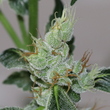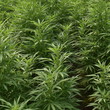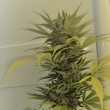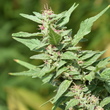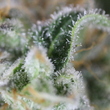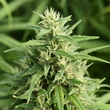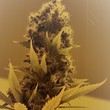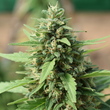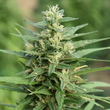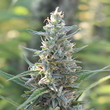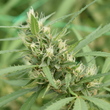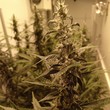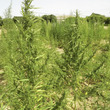Introducción
The ornamental cultivar ‘Divina’, being characterized by a variegated foliage as morphological marker, is the first Cannabis cultivar that has obtained a provisional protection of plant breeder's rights at the Community Plant Variety Office (CPVO). The variegated foliage allows the visual identification of the cultivar, and the distinction from the medicinal cultivar ‘Pilar’ where the spontaneous mutated type of chimera was detected and isolated. Both cultivars are characterized for having the not psychotropic compound cannabidiol (CBD) as predominant cannabinoid. Plants of ‘Divina’ have a significant lower content of chlorophyll in their leaves than plants of ‘Pilar’. A slower growth rate and less total biomass production have been generally observed with ‘Divina’ when mother plants of both cultivars are grown at similar conditions under long day length, supposedly due to the inability to synthesize chlorophyll in portions of the photosynthetic organs.
The main objectives of this article were to evaluate yield losses or gains in vegetal raw material components (stalks, leaves and inflorescences) between the mutated ‘Divina’ and the not mutated ‘Pilar’, as well as cannabinoid and terpenoid yields and possible changes on specific secondary metabolites due to genomic mutation
Materiales y métodos
The comparative production trial was performed at Phytoplant Research authorized facilities in Córdoba (Spain). A cabinet for indoor cultivation of 2 m2 of cultivated area was used. A total of 8 plants for each cultivar (8 plants m-2) were cultivated. The cabinet was equipped with two 600 W m-2 Philips Greenpower 600W 400V EL lights providing a photon flux density of approximately 700 μmol m-2 s-1. Plants were cultivated in 8.5 L pots filled and maintained for 4 weeks in vegetative stage under long day length (18 h light day-1) and then induced to flower under short day length (12 h light day-1) and maintained for an additional 5 weeks, when plants were harvested and data on individual plant height and total fresh weight (FW) were taken. The range adopted for climatic parameters were 25±3°C, 50-70% of relative humidity, and 350-400 ppm of carbon dioxide. Plants were cultivated on a coconut natural growth medium (Coco Professional Plus, Canna Continental, Los Angeles, CA) and nutrient solutions were prepared by using the fertilizers Coco A+B from Canna Continental. The method described by Lichtenthaler (1987) for extracting and quantifying chlorophyll in μg mL-1 was employed to measure chlorophyll in ‘Pilar’ (not mottled green leaves) and in ‘Divina’ (variegated leaves) from 6 samples of each cultivar taken from representative leaves. After the drying stage, data on total dry weight (TDW) were obtained after manual processing, separation and taking the respective data on dry weights of vegetal raw material components: leaves (LDW), inflorescences (FDW), and stalks (SDW). Approximately 5 g of inflorescences and 5 g of leaves were sampled for each one of the 16 plants. Samples were differently prepared, stored and extracted before cannabinoid and terpenoid analysis, depending on the secondary metabolites to be analyzed. For cannabinoid analysis, a Agilent 7890 B gas chromatograph was used. Compounds were detected by mass spectrometry using a MS 5977B from Agilent and for terpenoid analysis, a Agilent 7820 B gas chromatograph was used.
Resultados
Results obtained on chlorophyll contents confirmed that a deprived photosynthetic activity resulted in less total biomass accumulation in the stalks, the only vegetal raw material component not of interest for obtaining Cannabis-based medicines. In fact, no significant differences were found on FW, TDW, LDW and FDW, confirming that similar yield of the vegetal raw material components (leaves and inflorescences) used for extracting cannabinoids and terpenoids can be obtained from both cultivars, although slightly higher yields on LDW and FDW were obtained from plants of ‘Pilar’. Our results suggest that synthesis and accumulation of cannabinoids in glandular trichomes within inflorescences and leaves tissues devoid of chlorophyll may be inferior than in tissues with higher content of chlorophyll. We detected an opposite behavior on terpenoids content in inflorescences, suggesting that glandular trichomes within inflorescence tissues devoid of chlorophyll have similar terpenoid synthesis and accumulation to glandular trichomes within inflorescence tissues with higher content of chlorophyll.
Conclusión
Plants of ‘Divina’ cultivated for their esthetic value could be eventually harvested and used as herbal remedy without any potential risk of abuse, giving a consistent added value to this dual-purpose cultivar. Extensive exploitation of an ornamental variegated Cannabis cultivar as starting material could be potentially considered for obtaining essential oil and CBD-enriched extracts with deprived residues of chlorophyll, as well as pure forms of CBD, especially when production of vegetable raw material takes place in countries with restrictive rules on exploiting this plant species and where a morphological marker could make a difference on permitting its cultivation.
Otras publicaciones
Ver más
Ver más
Ver más
Ver más
Ver más
Ver más
Ver más
Ver más
Ver más
Ver más
Ver más
Ver más
Ver más
Ver más
Ver más
Ver más
Ver más
Ver más
Ver más
Ver más
Ver más
Ver más
Ver más
Ver más
Ver más
Solicita información
¿Te podemos ser de ayuda? ¿Tienes alguna duda sobre nosotros? Escríbenos y contactaremos contigo cuanto antes.
